Top 10 Foods Highest in Histidine
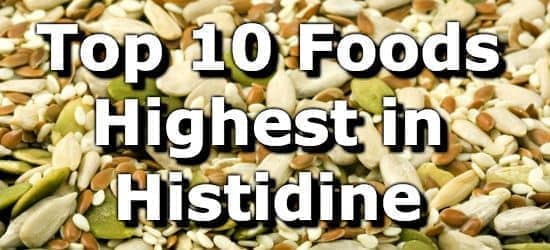
Histidine is an essential amino acid required for growth and tissue repair, blood cell production, and creation of the neurotransmitter histamine. Histidine can even help protect tissues from damage caused by radiation or heavy metals. (1)
High histidine foods include pork, beef, lamb, chicken, turkey, fish, soy, beans, milk, cheese, nuts, seeds, whole grains, and eggs. (2) The reference dietary intake (RDI) of histidine is 10mg per kilogram of body weight or 4.5mg per pound. A person weighing 70kg (~154 pounds) should consume around 700mg of histidine per day. (3)
Below is a list of the top 10 foods highest in histidine with the %RDI calculated for someone weighing 70kg (154lbs). For more high histidine foods see the extended list of histidine-rich foods.
-
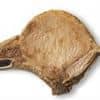 1. Pork Chops
1. Pork Chops
Histidine
in 1 Pork ChopHistidine
per 100gHistidine
per 200 Calories2225mg
(318% RDI)1080mg
(154% RDI)847mg
(121% RDI)More Pork Products High in Histidine
- 227% RDI in a cup of lean roast ham
- 133% RDI in a bratwurst
- 72% RDI in 3 slices of bacon
-
 2. Beef (Skirt Steak)
2. Beef (Skirt Steak)
Histidine
per 6oz SteakHistidine
per 100gHistidine
per 200 Calories2198mg
(314% RDI)1293mg
(185% RDI)965mg
(138% RDI)More Red Meat High in Histidine
- 147% RDI in 3oz of lamb roast
- 138% RDI in 3oz of beef roast
- 101% RDI in a 3oz hamburger
-
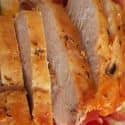 3. Lean Chicken Breast
3. Lean Chicken Breast
Histidine
in a 6oz BreastHistidine
per 100gHistidine
per 200 Calories2032mg
(290% RDI)1195mg
(171% RDI)1522mg
(217% RDI)More Poultry High in Histidine
- 262% RDI in a roast chicken leg
- 99% RDI in 3oz of turkey roast
- 93% RDI in a 3oz turkey patty
-
 4. Tuna
4. Tuna
Histidine
in a 6oz FilletHistidine
per 100gHistidine
per 200 Calories1496mg
(214% RDI)880mg
(126% RDI)957mg
(137% RDI)More Fish High in Histidine
- 188% RDI in a 6oz snapper fillet
- 182% RDI in a 6oz salmon fillet
- 173% RDI in a 6oz cod fillet
See all fish high in histidine.
-
 5. Firm Tofu
5. Firm Tofu
Histidine
per CupHistidine
per 100gHistidine
per 200 Calories1086mg
(155% RDI)431mg
(62% RDI)599mg
(86% RDI)- 110% RDI per cup of boiled soybeans
-
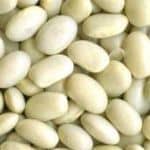 6. Canned Navy Beans
6. Canned Navy Beans
Histidine
per CupHistidine
per 100gHistidine
per 200 Calories542mg
(77% RDI)207mg
(30% RDI)366mg
(52% RDI)More Beans High in Histidine
- 72% RDI per cup of lentils
- 67% RDI per cup of kidney beans
- 64% RDI per cup of white beans
See all beans high in histidine.
-
 7. Milk
7. Milk
Histidine
per 16oz GlassHistidine
per 100gHistidine
per 200 Calories500mg
(71% RDI)102mg
(15% RDI)600mg
(86% RDI)More Dairy High in Histidine
- 82% RDI per 1/2 cup of ricotta
- 56% RDI per oz of grated Parmesan
- 50% RDI per cup of yogurt
See all dairy foods high in histidine.
-
8. Seeds (Squash and Pumpkin Seeds)
Histidine
per 1oz HandfulHistidine
per 100gHistidine
per 200 Calories219mg
(31% RDI)770mg
(110% RDI)268mg
(38% RDI)More Nuts and Seeds High in Histidine
- 39% RDI per oz of hemp seeds
- 22% RDI per oz of almonds
- 22% RDI per oz of sunflower seeds
- 22% RDI per oz of pistachio nuts
- 22% RDI per oz of chia seeds
- 19% RDI per oz of flax seeds
See all nuts and seeds high in histidine.
-
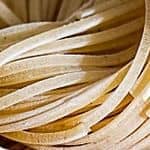 9. Whole Wheat Pasta
9. Whole Wheat Pasta
Histidine
per CupHistidine
per 100gHistidine
per 200 Calories164mg
(23% RDI)140mg
(20% RDI)188mg
(27% RDI)More Grains High in Histidine
- 36% RDI per cup of kamut
- 34% RDI per cup of quinoa
- 32% RDI per cup of teff
- 19% RDI per cup of brown rice
- 18% RDI per cup of oatmeal
See all grains high in histidine.
-
 10. Eggs
10. Eggs
Histidine
in 1 Large EggHistidine
per 100gHistidine
per 200 Calories149mg
(21% RDI)298mg
(43% RDI)385mg
(55% RDI)
Printable One Page Sheet
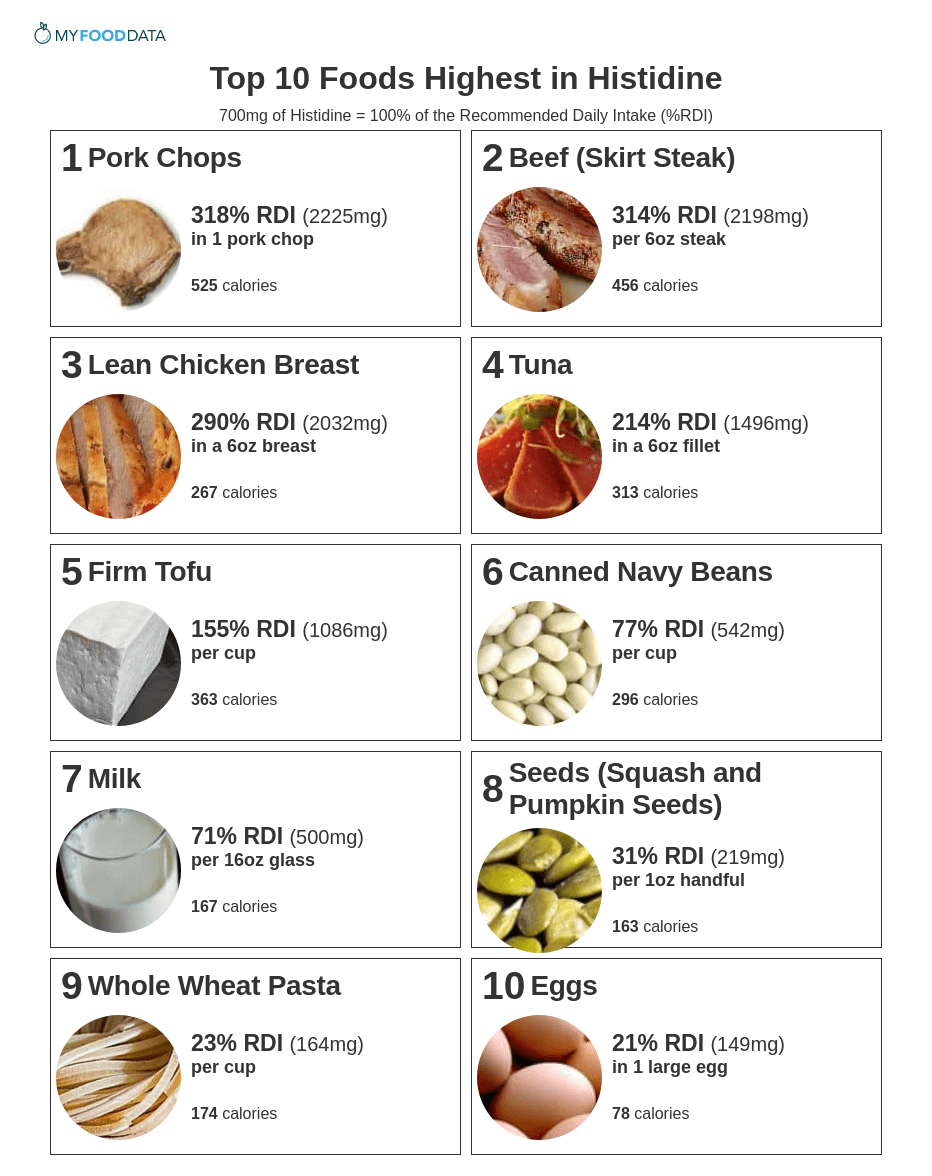
More Histidine Rich Foods
| Food | Serving | Histidine |
|---|---|---|
| 1. Subway Tuna Sub | per 6 inch sub | 232% RDI (1626mg) |
| 2. Kielbasa Sausage | per large link | 189% RDI (1321mg) |
| 3. Cooked Eel | per 5.6oz fillet | 158% RDI (1107mg) |
| 4. Soy Based Protein Powder | per 2oz scoup | 97% RDI (680mg) |
| 5. Toasted Wheat Germ | per oz | 33% RDI (230mg) |
| 6. Canned Eastern Oysters | 1 cup (drained) | 31% RDI (220mg) |
| 7. Gelatin | per 1oz package | 26% RDI (185mg) |
| 8. Peanut Butter | per 2 tblsp | 25% RDI (178mg) |
| 9. Green Peas | per cup cooked | 24% RDI (168mg) |
| 10. Fish Roe (Ikura, Caviar) | per tblsp | 12% RDI (85mg) |
From the Nutrient Ranking Tool
Use the ranking tool links below to select foods and create your own food list to share or print.
- Foods High in Histidine
- Foods Low in Histidine
- Vegetables High in Histidine
- Fruits High in Histidine
- Vegetarian Foods High in Histidine
- Nuts High in Histidine
- Grains High in Histidine
- Beans High in Histidine
- Dairy High in Histidine
- Breakfast Cereals High in Histidine
- Fast Foods High in Histidine
View more nutrients with the nutrient ranking tool, or see ratios with the nutrient ratio tool.
Related
- Amino Acid Protein Calculator
- High Phenylalanine Foods
- High Valine Foods
- High Cysteine Foods
- High Methionine Foods
- High Threonine Foods
- High Leucine Foods
- High Tryptophan Foods
- High Protein Foods
- Vegetables Highest in Protein
- Fruits Highest in Protein
- Cheeses Highest in Protein
- Beans and Legumes Highest in Protein
Data Sources and References
- NIH Pubchem Histadine Entry
- U.S. Agricultural Research Service Food Data Central
- World Health Organization (WHO) Technical Report Series – Protein And Amino Acid Requirements In Human Nutrition ISBN 978 92 4 120935 9
Try the recipe nutrition calculator, or daily meal planner.
Create a free account to log and track foods.

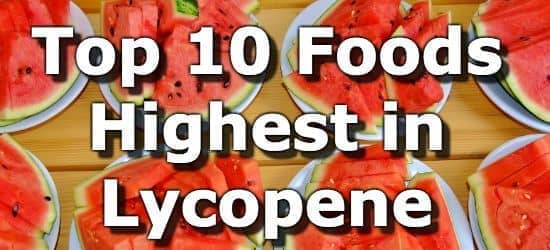 Next ➞
Next ➞